Create
Vintage St. Pete: St. Petersburg Little Theatre
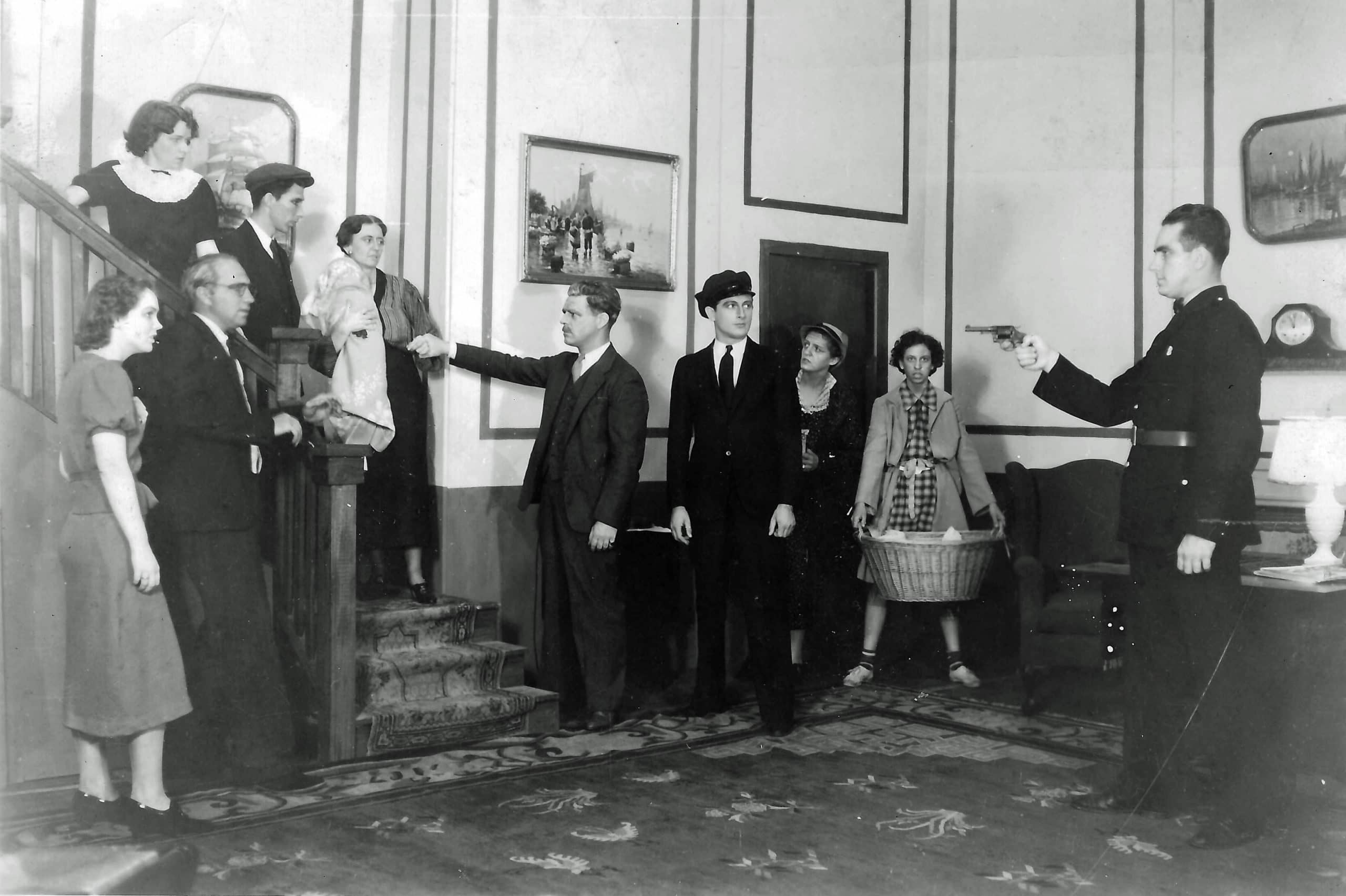
After the turn of the 20th century, small theater companies began to sprout in communities across America, dedicated to putting plays on the stage that defied what was then the norm: Oversized melodramas and rote comedies, surefire-hit touring shows financed by out-of-town producers with eyes set squarely on profits, and the baggy-pants follies of vaudeville.
Organized by playwrights, academics and ardent fans of the current European model (experimental plays, news works by new writers, stories that pushed societal boundaries), the “Little Theatre Movement” arrived just as motion pictures were stealing away audiences, to be followed in subsequent decades by radio and television.
Ah, but the theater did not die.
Some of the earliest little theatres were founded by, and staffed with, theater professionals. These morphed into well-known incubators. Many others, those that grew out of ladies’ clubs, reading societies and amateur groups, became significant cultural forces in their communities.
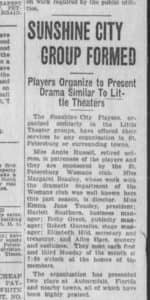
1926
Through her association with the St. Petersburg Woman’s Club, former stage actress Margaret Beazley established the Sunshine City Players in 1925.
“We offer our services to any organization desiring dramatic entertainment,” Beazley’s publicity director, Betty Gresh, wrote in a St. Petersburg Times editorial. “A real enthusiasm for the drama and a willingness to work and give one’s best, are the only requirements for membership in the Sunshine City Players.”
Nearly a century later, Betty Gresh’s words are still at the heart of St. Petersburg City Theatre’s manifesto. Between 1933 and 2010, it was known as St. Petersburg Little Theatre, and although the name and the players – and the plays – have changed over the years, it’s essentially the same organization as Margaret Beazley’s Sunshine City Players .
Community members join together to put on plays. That’s about it.
Actors, directors, producers, stage hands, costume, makeup, lighting, everything that’s needed is self-contained (although the play scripts, and there are plenty available, are rented, and royalties are paid).
As St. Petersburg City Theatre’s centennial approaches, amateur theater might not be the cultural powerhouse it was in the 1940s and ‘50s – there are way more distractions these days – but it remains a cornerstone of community life in America. When Mickey Rooney and Judy Garland called out “Hey kids, let’s put on a show!” way back when, they were addressing the residents of Anytown, U.S.A.
A theatrical timeline
1933. Now calling itself the Players Club, Beazley’s group makes a move to distance itself from its local competitors, including the play-producing St. Petersburg Art Club, by hitching its wagon to the Little Theatre wave sweeping America. On May 9, a new moniker is announced: The St. Petersburg Little Theatre. Directors are chosen and meetings held at the Vocational School. The first two organized shows, The Poor Nut and Outward Bound, are presented in the Mirror Lake Junior High auditorium.
The SPLT production of the one-act Caleb Stone’s Death Watch takes first place at the 1934 state Little Theatre tournament in Clearwater; by the following year, the contest will be discontinued.
1937. Incorporating as a nonprofit, St. Petersburg Little Theatre hires ex-British Royal Marine “Captain” Patrick Walters, a one-time actor and vaudevillian, as a paid director at $15 per week. Walters, who had married a St. Petersburg woman, told the Evening Independent he would shortly be offering courses in “acting, makeup, designing, construction, painting and stage-managing. Next season, I would like to include three other courses, namely, costumes, lighting and writing.”
Walters’ hire was to be a game-changer. In a large advertisement for the first play under his regime, Post Road (at 35 cents per ticket), the board trumpeted “Our Creed,” most likely penned by the incoming director himself: WE BELIEVE: That the Little Theatre is a definite part of the civic and social life of our Community; that its chief purpose is to afford every individual who really desires it, opportunity for self-expression in the Arts of the Theatre – without thought of payment therefor; that the democratic fulfillment of this purpose makes certain that the drama as an art and an educational and spiritual influence shall not die.

1940
1942. Walters departs to take care of military business in World War II. Concerned that the public believes their plays are high school productions, SPLT reps go looking for a replacement for the school auditorium, and locate an empty building at 1950 2nd Avenue North, a former grist mill turned upholstery room turned auto-painting shop. The board pays $3,600 for the place, half up front and the rest in the form of a mortgage.
This is when St. Pete started putting the community in community theater:
When it became known that a stage was needed in the old building, the carpenter’s union offered to build it. The plasterer’s union replastered the outside of the building and, in fact, were so generous that it took very tactful handling to keep them from plastering the inside of the building which would have destroyed the rough unfinished appearance desired for atmosphere. A string of footlights were donated by one of the schools. The American Legion presented 300 seats which they were discarding from an outdoor boxing arena. The plumbers gave their time and material. Definitely not inconsequential were the members who rolled up their sleeves and pitched in.
From “An Early History of St. Petersburg Little Theatre” by Roberta Morrill, 1949
The good fight
The war years proved tough, as young men were in short supply for community productions. And with tires and gasoline severely rationed, fear set in that business would fall off dramatically.
Yet the St. Petersburg Little Theatre was one of the few in the country to remain open, with older men filling in, and the younger ones who weren’t overseas – or about to be drafted – recruited for multiple shows per season.
Because several branches of the Armed Forces operated bases for training and physical rehabilitation in the area (specifically, the Vinoy Park Hotel and the Don Ce Sar), there were always soldiers and personnel on the lookout for good entertainment.
A 1943 production of the comedy Arsenic and Old Lace (the fifth play in the new building) broke all previous records: “People kept pouring in until they were literally hanging from the rafters,” Roberta Morrill wrote. “One player tells of looking out over the footlights and seeing a youngster sitting on one of the ceiling beams.” The mortgage was paid off in 1944.
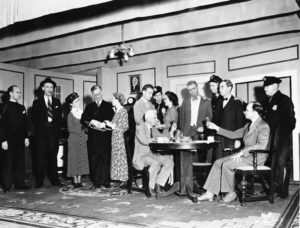
Despite the war, “Arsenic and Old Lace” drew record crowds in January, 1943.
A theatrical timeline – Act II
1955. SPLT’s first show for children, Snow White and the Seven Dwarfs, debuts with a combination of young and grown-up actors (In the Times: “Willa Mae Runyon, seen in I Remember Mama, has the role of Snow White … Vince Bouse, new romantic lead at Little Theatre, has the part of the prince.”)
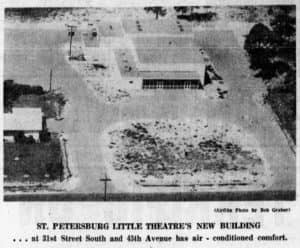 1957. The board purchases a 3.2 acre lot on 31st Street South and construction begins on an all-new, 250-seat theater building. Total cost is $100,000 – SPLT takes on a $60,000 mortgage – and the custom design includes ample backstage and dressing room space, costume and set storage, and a screened veranda which will ultimately be closed in to create a spacious lobby. The first production, in September 1958, is Teahouse of the August Moon.
1957. The board purchases a 3.2 acre lot on 31st Street South and construction begins on an all-new, 250-seat theater building. Total cost is $100,000 – SPLT takes on a $60,000 mortgage – and the custom design includes ample backstage and dressing room space, costume and set storage, and a screened veranda which will ultimately be closed in to create a spacious lobby. The first production, in September 1958, is Teahouse of the August Moon.

“The Pajama Game,” 1966.
1966. SPLT’s first musical: The Pajama Game. “Nothing could cheer the heart of a tired businessman more,” the Times reviewer writes. “Not only are the girls beautiful – but some can drink beer from bottles without removing the cap.” Despite such odd plaudits from the local press, the show is a hit, and musicals will henceforth take up a good portion of SPLT schedules.
1972. A production of the long-forgotten “rock musical” Your Own Thing, based loosely on Shakespeare’s Twelfth Night, is a smash, as is Hot Pants Revue, but otherwise sagging ticket sales mean a financial crisis for the theater (not for the first, or the last, time). Dinner theaters, featuring fading show business “names,” are all the rage. To raise money, old costumes, props and other ephemera are sold off in a garage sale. Tickets prices are raised from $3.50 to $4.
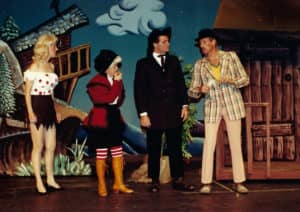
“Lil Abner,” 1990.
1983. The 1958 mortgage is paid off. Theater classes for children begin.
1994. Major renovations, including a restroom wing to meet ADA standards.
1997. The first “lobby show,” the musical Jung at Heart.
2005. SPLT hires its first-ever executive director, a paid position.
2011. The name is officially changed to St. Petersburg City Theatre. Year after year, the (mostly) all-volunteer theater is able to meet its meager operating budget through ticket sales, donations, children’s camps and the occasional fundraiser.
2017. The wheels fall off. The old “pay-to-play” financial arrangement – keeping just enough money in the till to cover expenses for each show – stops working. The existing board members are tired. Only the youth summer camps are generating money. Amid a pile of the debt, the board lets the theater’s four paid employees go, and announces that St. Pete City Theatre will close, less than a decade before its centennial.

Children’s camp: Cast of “The Little Mermaid,” 2017. Photo by Bill DeYoung.
A group of parents, whose children are involved in SPCT’s youth theater programs, convinces the outgoing board to give them a shot at keeping things running, in true Mickey and Judy fashion. “We didn’t know what we were doing,” says Lisa Marone, part of the original “save the theater” crew. “We just knew we didn’t want to see it close.”
Just one paid employee is brought back – Kevin Crowell, who works with the kids, the board and the volunteers, builds and paints sets, hauls, carries, repairs, schleps and hustles. Today, he remains an invaluable asset.
2018-19. Approximately $400,000 in repairs are completed at the 14,000-square-foot theater, including a new roof and air conditioning system. Additional upgrades are made.
2020. The theater gets through the pandemic shutdown era with virtual productions.
The good fight continues
Financial difficulties, for any nonprofit, are cyclical (if not constant). The archived paperwork for St. Petersburg Little Theatre is full of dire predictions about the future, that there soon won’t be any money, that ticket sales are down, et cetera.
Yet this little theater that could, did. In St. Petersburg, it’s King of Rebound Hill.

“A Christmas Carol” cast, 2021.
“I think the history of the theater is so important for us to have, as points of reference,” says Marone, whose current title is Fundraising Chair. “To understand that in this somewhat chaotic world that we live in, and the social media that’s constantly bombarding us, that we’ve been here before. We really have. It’s just that we have to approach it a different way sometimes. And there’s more people watching.”
St. Petersburg City Theatre has hit some big bumps along the way, but its title – the oldest continually-operating community theater in Florida – is worn like a badge of honor.
There’s a reason, Marone believes, live community theater has endured, and will endure, despite TV and streaming, downloading, video games, social media and the other constant distractions of the era.
It’s the human component.
“There’s nothing in this digital world that can give you that sustaining feeling of applause when you’re onstage,” she explains, “and then walking into the lobby and meeting the members of the audience afterwards.”
St. Petersburg City Theatre website.







